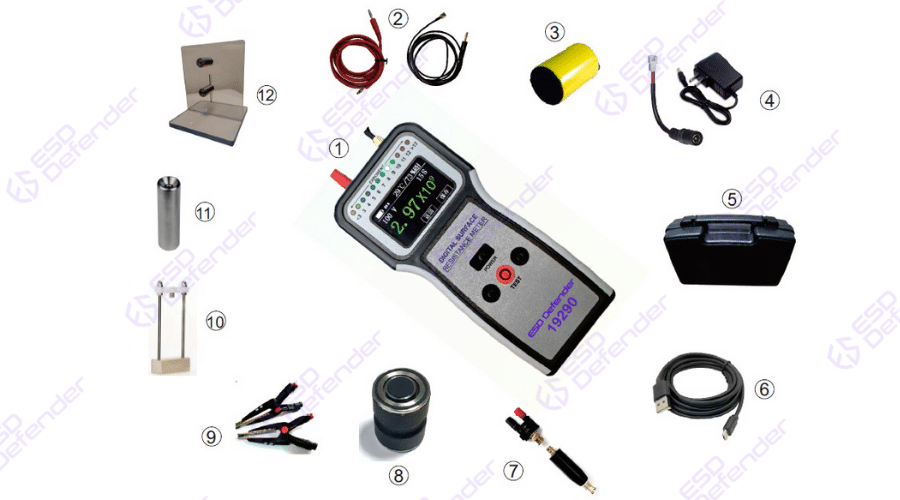What is surface resistance meter?
Surface resistance meter, also called surface resistivity meter, is an instrument used to measure the electrical resistance of materials includes work surface, garements, footwears, wrist straps, ESD chairs, ESD floor system and more.
The surface resistance meter determines how well the material can dissipate static electricity, crucial for preventing ESD-related damage to sensitive electronic components.
What is surface resistance?
Surface resistance refers to the ability of a material’s surface to resist the flow of electric current. It is the ratio of the electric field to the current density at a given point on the material’s surface per unit area. Surface resistance is typically measured in ohms (Ω).
What is the purpose of the resistivity meter?
The primary purpose of a surface resistance meter is to measure the electrical resistance or resistivity of a surface material. This measurement is crucial for:
1. Electrostatic Discharge (ESD) Control
- Surface resistance indicates a material’s ability to dissipate static electricity.
- Proper ESD control requires surfaces to have resistance within specified ranges to safely dissipate static charges.
2. Monitoring Material Properties
- Surface resistance can reveal changes in a material’s conductive properties over time, temperature and humidity.
- This helps ensure materials maintain their intended static-dissipative or conductive characteristics, such as flooring, mat, footwear and others
3. Evaluating Compliance with ESD Standards
- Many industries have standards that specify acceptable surface resistance ranges.
- Surface resistance meters are used to verify compliance with these ESD control standards.
4. Troubleshooting ESD Issues
- This allows for targeted improvements to ESD control measures.
- Measuring surface resistance can help identify the root causes of ESD problems in a facility.
How much does a surface resistance meter cost?
The cost of a surface resistance meter can vary depending on the manufacturer, features, and accessories. Typically, they range in price from around US$300 to US$2,000.
ESD Defender 19290 is worth considering, as it not only measures resistance, volume resistance, RTG, and RTT, but also provides temperature and humidity measurements, offering comprehensive data for ESD control. Welcome to contact us for a special pricing.
How to measure surface resistivity?
Different materials require distinct testing methods and associated equipment to ensure accurate measurements.
For work surfaces, two 5 lbs. electrodes are used to apply voltage and measure current for resistivity calculations. Antistatic packaging is tested with a concentric ring probe, which uses conductive rings to analyze electric field interactions. Gloves and finger cots require a Constant Area & Force Electrode to ensure consistent pressure during measurements.

Adhering to standardized protocols, like ESD TR53、IEC TR61340-5-4, is vital for reliable results. Proper equipment calibration and consideration of environmental factors, such as humidity and temperature, are also important.

- Connect the red and black terminals of the concentric ring electrode to the ESD Defender 19290 meter.
- Place the concentric ring electrode with the concentric circular faces facing down on the material to be tested.
- Press the button to start the test.
For more information on testing methods, please check below vidoes or reach out: esd@macrosafegates.com
Difference Between Resistivity & Resistance
Many people often confuse resistivity and resistance, or even think that they are the same. However, they are two completely different concepts, especially when it comes to static control.
Resistance is a measure of how much a material or a component opposes the flow of electric current. It is denoted by the symbol R and is measured in ohms. Resistance depends on the material, its dimensions, and temperature. In static control applications, resistance is crucial as it determines the ability of a material to limit or allow the flow of static electricity.
On the other hand, resistivity, represented by the symbol ρ (rho), is an intrinsic property of a material that describes how strongly it resists the flow of electric current. Resistivity is a characteristic of a material and is independent of its shape or size. It is measured in ohm-meters (Ω⋅m) and is crucial in the design and selection of materials for static control applications. Materials with low resistivity are good conductors of electricity and are often used in applications where efficient dissipation of static charges is required.
Values of surface resistance and surface resistivity become comparable if the measured surface resistance value is multiplied by the geometrical coefficient of the used electrode fixture.¹
According to ESD TR53 and utilizing a professional surface resistance instrument like the ESD Defender 19290, when the surface resistance value of a material is measured, the corresponding surface resistivity can be calculated using the formula: p=U/I*k=R*K, where the resistance value is multiplied by the geometric coefficient factor k=10 to derive the surface resistivity.
REFERENCE
1.Dr. Jaakko Paasi, VTT Industrial Systems: “Surface resistance or surface resistivity?
What is the standard for surface resistance?
The standard methods for measuring surface resistance of different materials are described in detail in the international standard of IEC 61340-4 series, and relevant ESD standards and specifications that pulished by EOS/ESD Association, Inc.
| Subject Matter | IEC Documents | ESDA Documents |
| Flooring | IEC 61340-4-1 | ANSI/ESD STM7.1 |
| Footwear | IEC 61340-4-3 | ANSI/ESD STM9.1 |
| Footwear and Flooring Systems | IEC 61340-4-5 | ANSI/ESD STM97.1 & ANSI/ESD STM97.2 |
| Wrist Straps | IEC 61340-4-6 | ANSI/ESD S1.1 |
| Ionization | IEC 61340-4-7 | ANSI/ESD STM3.1 |
| Shielding Bags | IEC 61340-4-8 | ANSI/ESD S11.31 |
| Garments | IEC 61340-4-9 | ANSI/ESD STM2.1 |
What is the purpose of the resistance meter?
A surface resistance meter is designed to measure the electrical resistance of a surface, usually in ohms. They help in determining surface resistivity to assess how effectively a surface can dissipate static charge. Surface resistance meters are primarily used in industries where static electricity can be a concern, such as electronics manufacturing, pharmaceuticals, and clean rooms.
